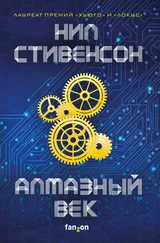This was a pretty good board on pretty good powder—certainly an improvement on anything Laks had enjoyed at the crowded and waterlogged ski areas just outside of Vancouver. By agreement, Major Raju had procured a used board from a secondhand shop in Kashmir, and they’d scuffed it up a bit to make it look more ragtag, optics-wise.
Lan Lu certainly didn’t see it coming. Or if he did he didn’t understand how fast Laks was traveling. Not a winter sports aficionado, apparently. Anyway Laks was on him before he could get his guard up. Laks cut the Blue Heron’s legs out from under him as he schussed by, then banked into a hard U-turn on the flat and came back around toward his fallen foe. He pulled up well short, though, to give himself a few moments to kick out of his hard plastic boots—not a good fit with light-footed gatka movements. As he was doing this he had a clear view past Lan Lu and back up the western slope, now in brilliant red sunlight—all the sunrises lately had been glorious—to check on the progress of the School. They were almost down, to the point where some members of the Flock were wheeling to meet them.
Toward Lan Lu he trudged in his stocking feet through knee-deep snow. The Blue Heron was up, dusting snow off his long changshan robe. Good. No broken legs. Keeping an eye on Laks, he looked around until he saw where his blue-and-gold stick had fallen, then picked that up. Looking past Laks he held up a hand to stop three Blue Herons who had been rushing to their master’s defense. With his eyes he drew their attention to the barracks. Indian defenders from the upper stories were now emerging from it to close the jaws of the trap.
Then Lan Lu raised his stick and faced off against Laks and settled into the stately guard position that Laks had admired in so many YouTube videos.
Because of what happened afterward, Laks didn’t get to watch Pippa’s supercut of the fight until much, much later. But it was certainly his impression until close to the end that he was getting his ass handed to him. There was a reason Lan Lu had been at the top of the leaderboard for most of this year. Laks had been so focused on his opponent’s close quarters techniques that he wasn’t ready for the standoff fight that actually ensued. They never seemed to close to within two meters of each other. Lan Lu wasn’t using stick technique at all. He was using spear technique. This turned out to work damned well. He had a way of making his stick flex around Lak’s defenses and tag him in the ribs or the side of the head. Which was confusing and upsetting, because you don’t expect to get hit in the side, or sometimes even in the back, by an opponent who is six feet away and in front of you.
But the weakness of all spear technique was what happened when you got close—too close for the spear’s head to be of any use. Laks remembered Sam’s first fight against the Bonking Head at Pangong Tso when he had just barreled in, absorbing damage until he was inside the other guy’s preferred range. Laks finally managed to do that. He even put his big steel kara to use blocking, then deflecting a strike. Which brought him in range of the feared nerve center strikes of Lan Lu’s kung fu; but unbeknownst to Lan Lu it brought Lan Lu in range of the short powerful strikes that Laks had grafted on to traditional gatka. Lan Lu got in one terrific shot behind the angle of Laks’s jaw that nearly felled him and left the whole side of his face numb. But Laks fell toward Lan Lu, rather than away from him, which probably saved the day. For out of that collision Laks was able to emerge with a series of punches, using the last six inches of his stick as a force multiplier, that drove Lan Lu back shouting with pain and surprise and toppled him into the snow. He held up a hand. The fight was over. Big Fish had won. Money was changing hands in Vegas. Territory was about to change hands up here.
EINDHOVEN
It had been a long time since Willem had read an official document produced on a typewriter. This one bore the date August 14, 1962. Its author was Freeman Dyson. Each page was stamped SECRET at top and bottom, but someone had gone through with a Sharpie and drawn a slash through each repetition of that word; apparently it had been declassified at some point in the last half century.
Not that it mattered in his case; he, and everyone else in this shipping container, had the clearances needed to read this document whether it was classified or not.
PROGRAM FOR A STUDY
Implications of New Weapons Systems for Strategic Policy and Disarmament
. . . followed by a quotation from William Wordsworth’s Sonnet on Mutability , which was apparently the sort of literary touch you could get away with when you were Freeman Dyson and it was 1962. At a glance—which was all Willem had time for, as the presentation was getting underway—this was a survey of eight hypothetical new weapons systems that military planners in the United States had been worried about during the Kennedy administration. Some of them (supersonic low-altitude missiles, small portable ballistic missiles) still looked quite relevant. Which presumably explained why this chap from MI6 had gone to the trouble of reproducing the document and handing out copies. He’d flown over from London this morning and would fly back in a few hours. He was addressing a group of half a dozen Dutch colleagues in a SCIF—a Sensitive Compartmented Information Facility—near Eindhoven Airport. Inevitably, this particular SCIF was a portable unit built into a shipping container. This meant it was only eight feet wide, which made it a cramped environment for the invited guests. Most of them were military or intelligence. Willem wasn’t, but he’d been invited anyway, for reasons that had not yet been made evident to him.
“You’ve probably heard of the Tsar Bomba,” said the Brit, who was going by Simon.
“The biggest H-bomb ever detonated,” said the minister of defense.
Simon nodded. “The Russians set it off about ten months before Mr. Dyson wrote this.” He put his hand on the document. “The interesting takeaway was that despite its fifty-megaton yield, it didn’t do as much damage as expected. Why? Because the earth is hard and the atmosphere is quite yielding—and only gets more so the higher up you go. So the explosion sort of ricocheted off the ground and went the only way it could go and basically punched a hole through the atmosphere and dissipated its power into the void. For those in the know, the lesson learned was that making bigger bombs was a waste of resources. But Freeman Dyson understood that large bombs could still have military effect provided you worked out a way to detonate them in a medium that would contain the blast and absorb its energy, rather than just venting it into outer space. Such a medium is water. The scenario he describes here, starting on about page 6, is that a very large hydrogen bomb—much bigger than the Tsar Bomba, even—is deposited on the floor of the ocean offshore from the coastal region to be attacked. This is easy to do covertly using a submarine or just kicking it off a ship. When the bomb is later detonated, all its energy is deposited into the surrounding water, creating an artificial tsunami that crests over the nearby coastline and, to borrow a homely phrase from the Yanks, breaks a lot of things and hurts a lot of people. And I do mean a lot , in Dyson’s scenario. No one ever accused that man of not thinking big.”
“Are you working up to tell us that we got nuked the other day?” asked one of the Dutch intelligence analysts, half serious.
“No. As you know, a nuclear explosion would have left isotopic evidence. It also would have done a lot more damage than just wrecking one half of the Maeslantkering.”
Читать дальше
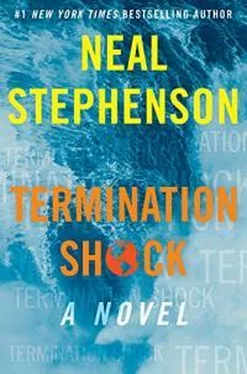
![Нил Стивенсон - Криптономикон [litres]](/books/23868/nil-stivenson-kriptonomikon-litres-thumb.webp)
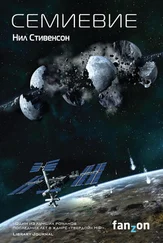
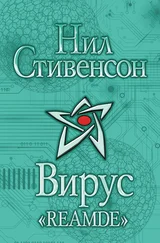


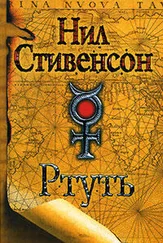
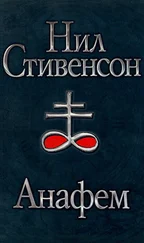
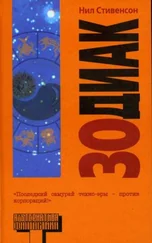

![Нил Стивенсон - Лавина [litres с оптимизированной обложкой]](/books/414066/nil-stivenson-lavina-litres-s-optimizirovannoj-ob-thumb.webp)
